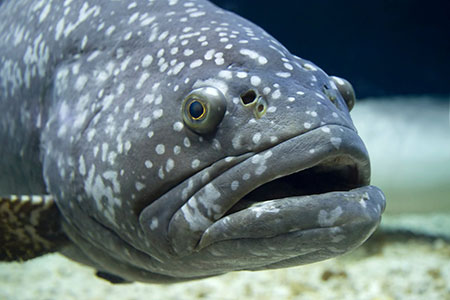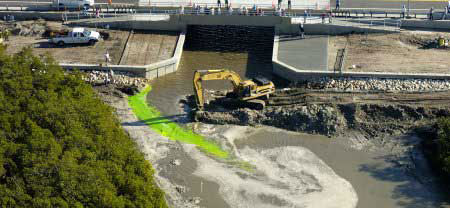EPC to publish Guide to Artificial Reefs
 More than 60 species of fish— including the ever-popular gag grouper, mangrove snapper, snook and tarpon — use artificial reefs in Tampa Bay. A new initiative wants to help fishermen become citizen-scientists who can track the success of the reefs, and then guide potential new development in the future.
More than 60 species of fish— including the ever-popular gag grouper, mangrove snapper, snook and tarpon — use artificial reefs in Tampa Bay. A new initiative wants to help fishermen become citizen-scientists who can track the success of the reefs, and then guide potential new development in the future.
The Guide to Artificial Reefs, which will be available at www.epchc.org later this spring, includes locational coordinates for the eight reefs constructed by Hillsborough County in Tampa Bay in locations as far north as the Courtney Campbell Causeway and as far south as Egmont Key.
“The goal with our artificial reef program, funded through the EPC’s Pollution Recovery Fund, is to increase habitat diversity,” notes Tom Ash, EPC’s assistant director for water management. “Enlisting fishermen to document the fish they catch makes them stakeholders in the program who can help guide us as we move forward.”
No plans for additional reefs are currently on the drawing board, he added. “If we do move forward, we’ll probably go with smaller, lower profile reefs that more closely mimic natural live-bottom habitats in the Bay.”
[su_divider top=”no”]Pinellas County prohibits “vacating” waterfront property
A new Pinellas County ordinance clearly prohibits “vacating” county-owned lands in neighborhoods where public rights-of-way separate private property from the waterfront in order to maintain water access for the general public.
“The parcels are generally not improved and what happened is that an adjacent landowner could request that the county vacate the land so they would be able to maintain it,” notes Kelli Levy, natural resources division manager for Pinellas County. “In the most recent case, adjacent homeowners wanted to build a large dock on county-owned land but it would have blocked access to the gulf for the rest of the neighborhood.”
The new ordinance prohibits abandoning, releasing or otherwise vacating rights-of-way to publicly accessible waters except in very limited circumstances where the landowner provides similar access in a nearby location.
[su_divider top=”no”]New app makes it easy to report invasives
A new app called IveGot1, available free to both iPhone and Android users, makes it easy to report invasive species found in the Tampa Bay watershed from the field.
The app uploads to EDDMapS and data, including images and GPS information, and is emailed directly to local and state verifiers for review. And it’s more than just an app — it’s an integrated invasive species reporting and outreach campaign that includes the app, a website with direct access to invasive species reporting and a hotline 1-888-IVEGOT1 for instant reports of live animals.
Invasive species like pythons and lion fish attract the most attention but invasions of other species, including Brazilian pepper, Australian pines and air potato alter our native landscape, adversely impact native wildlife, destroy agricultural crops and threaten our health. State officials estimate that invasions of exotic species cost taxpayers more than $500 million each year and that more than 1.7 million acres in Florida have been infested by invasive species.
By making it easy for hikers, bikers, riders and fishermen or sailors to report sightings of invasive animals and plants, the extent of infestations can be better assessed — and hopefully identified and controlled early.
Along with easy reporting that captures current locations and images, the app provides information on Florida’s worst invasive animals and plants, and real-time point distribution maps centered on your current location. For adventurous reporters far off the beaten track, it also can save data for uploading when the phone regains network access.
IveGot1 was developed by the University of Georgia Center for Invasive Species and Ecosystem Health through a cooperative agreement with the National Park Service, in cooperation with the Florida Fish and Wildlife Conservation Commission and the University of Florida Center for Aquatic and Invasive Plants. To download, visit www.IveGot1.org.
[su_divider top=”no”]Future of the Region awards categories revised & updated
A call for entries for the 2016 Future of the Region awards from the Tampa Bay Regional Planning Council will be available in late January with the awards event planned for April. New and updated categories will be included for the 24th annual awards presentation.
“The goal is to bring the awards more in line with the ONEBAY visioning (see http://www.tbrpc.org/onebay/pdf/2010_ONE_BAY_Vision.pdf) that incorporated the views of nearly 10,000 people across the region to plan for a Tampa Bay where a population that is expected to double by 2050 minimizes its impact on natural resources,” said Wren Krahl, director of administration and public relations.
For more information, visit http://www.tbrpc.org/events/for.shtml.
[su_divider]Pasco votes to join TBEP
The Pasco County Board of County Commissioners voted unanimously to accept the TBEP Policy Board’s invitation to join TBEP and to become a party to the Interlocal Agreement that has been so successful in restoring Tampa Bay.
The agreement is expected to be finalized with the unanimous approval of the TBEP Policy Board at its February meeting.
“The inclusion of Pasco County in the TBEP will provide representation of an important part of our watershed on the boards, and will enhance our regional approach to restoring and protecting Tampa Bay and its watershed,” said Holly Greening, TBEP executive director.
[su_divider]Fort DeSoto causeway opens lagoon to tidal flow

Following the success of a 2004 breached causeway that opened a once-closed lagoon at Fort DeSoto Park, Pinellas County has replicated the project to allow tidal flow into another closed section of the park.
“The causeway to the park blocked tidal flow and made Mullet Bay Bayou very stagnant and hot, with a tragic loss of seagrasses,” said Debbie Chayet, senior grants specialist for the county. “The first day we breached the causeway we saw fish swimming through and we’ve since observed more than 100 acres of seagrasses restored.”
The new project, on a peninsula used for maintenance equipment but seldom seen by the public, actually began in 2010, but complications caused by the area’s former use as an ordinance drop for Army training required a great deal of testing. “They’d actually found a 250-pound ordinance in 1984 so we didn’t want to begin digging without carefully checking for more.”
Construction began on a new bridge in May 2015 and Chayet is hopeful the causeway will be breached early this year.
[su_divider]